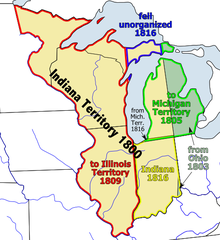
Back أراضي إنديانا Arabic Territori d'Indiana Catalan Indianaterritoriet Danish Indiana-Territorium German Territorio de Indiana Spanish Territoire de l'Indiana French טריטוריית אינדיאנה HE Territorio dell'Indiana Italian インディアナ準州 Japanese 인디애나 준주 Korean
| Territory of Indiana | |||||||||||||
|---|---|---|---|---|---|---|---|---|---|---|---|---|---|
| Organized incorporated territory of the United States | |||||||||||||
|
Flag | |||||||||||||
 | |||||||||||||
| Capital | Vincennes (1800–1813) Corydon (1813–1816) | ||||||||||||
| Population | |||||||||||||
• 1800 | 2,632 | ||||||||||||
• 1810 | 24,520 | ||||||||||||
• 1816 | 63,897 | ||||||||||||
| Government | |||||||||||||
| • Type | Organized incorporated territory | ||||||||||||
| Governor | |||||||||||||
• 1800–1812 | William Henry Harrison | ||||||||||||
• 1812–1813 | John Gibson (acting) | ||||||||||||
• 1813–1816 | Thomas Posey | ||||||||||||
| Secretary | |||||||||||||
• 1800–1816 | John Gibson | ||||||||||||
| History | |||||||||||||
• Indiana Organic Act passed | May 7, 1800 | ||||||||||||
• Indiana Organic Act coming into force | July 4, 1800 | ||||||||||||
• Treaty of Grouseland signed | March 1805 | ||||||||||||
• Michigan Territory created | June 30, 1805 | ||||||||||||
• Representation in Congress | December 12, 1805 | ||||||||||||
• Illinois Territory created - Treaty of Fort Wayne - Legislature popularly elected - Tecumseh's War - War of 1812 - Constitution drafted & adopted | March 1, 1809 September 30, 1809 November 1809 1811–1812 1812–1814 June 1816 | ||||||||||||
• Granted Statehood | December 11, 1816 | ||||||||||||
| |||||||||||||
The Indiana Territory, officially the Territory of Indiana, was created by an organic act that President John Adams signed into law on May 7, 1800,[1] to form an organized incorporated territory of the United States that existed from July 4, 1800, to December 11, 1816, when the remaining southeastern portion of the territory was admitted to the Union as the state of Indiana.[2] The territory originally contained approximately 259,824 square miles (672,940 km2) of land, but its size was decreased when it was subdivided to create the Michigan Territory (1805) and the Illinois Territory (1809). The Indiana Territory was the first new territory created from lands of the Northwest Territory, which had been organized under the terms of the Northwest Ordinance of 1787. The territorial capital was the settlement around the old French fort of Vincennes on the Wabash River, until transferred to Corydon near the Ohio River in 1813.
William Henry Harrison, the territory's first governor, oversaw treaty negotiations with the Native inhabitants that ceded tribal lands to the U.S. government, opening large parts of the territory to further settlement. In 1809 the U.S. Congress established a bicameral legislative body for the territory that included a popularly-elected House of Representatives and a Legislative Council. In addition, the territorial government began planning for a basic transportation network and education system, but efforts to attain statehood for the territory were delayed due to war. At the outbreak of Tecumseh's War, when the territory was on the front line of battle, Harrison led a military force in the opening hostilities at the Battle of Tippecanoe (1811) and in the subsequent invasion of Canada during the War of 1812. After Harrison resigned as the territorial governor, Thomas Posey was appointed to the vacant governorship, but the opposition party, led by Congressman Jonathan Jennings, dominated territorial affairs in its final years and began pressing for statehood.
In June 1816 a constitutional convention was held at Corydon, where a state constitution was adopted on June 29, 1816. General elections were held in August to fill offices for the new state government, the new officeholders were sworn into office in November, and the territory was dissolved. On December 11, 1816, President James Madison signed the congressional act that formally admitted Indiana to the Union as the nineteenth state.
- ^ Sixth Congress of United States (1845). Peters, Richard (ed.). "The Public Statutes at Large of the United States of America, Acts of the Sixth Congress of the United States, 1800, May 7, Statute I, Chap XLI" (PDF). Library of Congress. Boston: Charles C. Little & James Brown. p. 58. Retrieved 3 May 2023.
- ^ "Indiana". World Statesmen. Retrieved 20 July 2015.
© MMXXIII Rich X Search. We shall prevail. All rights reserved. Rich X Search
